
An Antarctic climate record from Mount Brown, East Antarctica
Centre for Ice and Climate in partnership with the Australian Antarctic Division, drilled a 295 metre long detailed climate record from a never-before-studied location in coastal East Antarctica in summer of 2018. The Mt Brown South climate record demonstrates how climate is changing in the Indian Ocean basin and constrain the impact of anthropogenic climate change across Antarctica and this poorly understood region of the Southern Hemisphere.
Along the 8000 km coastline of East Antarctica only one such record was previously available, from Law Dome (Longitude 112°E, south of Australia). To improve the geographical coverage of Antarctic climate records, a comprehensive climate record from Mt Brown in coastal East Antarctica (85°E) was drilled and analyzed using both ice core and borehole analysis. Key parameters that was reconstructed include past temperature, snow accumulation, snow/moisture source and sea ice variability.

The chief investigator of the Mount Brown South project is Dr Tessa Vance (Antarctic Climate & Ecosystems Cooperative Research Centre (ACE CRC)). Dr Paul Vallelonga (University of Copenhagen) is the leader of the Danish contribution to the project funded by the Carlsberg Foundation.

The Mount Brown South field team
| Sharon LaBudda, Australian Antarctic Division, Field leader |
| Pete “Bloo” Campbell, Australian Antarctic Division, Mechanic |
| Nerilie Abram, Australian National University, Ice core logger |
| Alison Criscitiello, University of Alberta, Ice core driller (https://www.ualberta.ca/earth-sciences/people/details.html?person=crisciti) |
|
Paul Vallelonga, University of Copenhagen, Ice core driller |
The Mt Brown South ice core drilling was completed using the Danish Hans Tausen (https://recap.nbi.ku.dk/about/) intermediate drill system which has also been successfully used in previous drilling projects at Renland ice cap (http://recap.nbi.ku.dk) in Greenland and Aurora Basin (http://www.antarctica.gov.au/science/climate-processes-and-change/antarctic-palaeoclimate/aurora-basin) in Antarctica.
Mount Brown South



